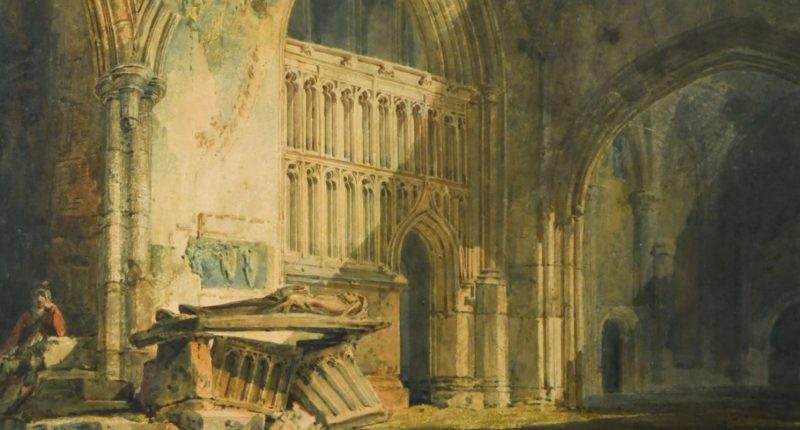A PAINTING bought at a clearance sale and used to decorate a dining room turned out to be worth thousands thanks to a hidden squiggle.
The watercolour was part of a stack of pictures being sold off as part of the contents of Georgian mansion in Suffolk at the beginning of the 1990s.
It cost just £100 and the buyer, who wants to remain anonymous, didn’t know who it was painted by but hung it in their dining room, where it stayed for 30 years,
The only clue as to who painted it was the name W Turner which had been inscribed on the back.
The buyer occasionally thought the painting maybe by the acclaimed English Romantic painter Joseph Mallord William Turner and eventually tried to find out for sure.
They checked through Tate’s Turner Bequest, containing thousands of paintings and sketches which the artist left to the nation after he died in 1851.
Read More on Paintings
In the South Wales Sketchbook, the owner discovered a similar but less developed drawing of a chapel which was part of St Davids Cathedral in Pembrokeshire.
TURNER’S TOUR OF WALES
Turner had made a tour of Wales in 1795 when he was 20 years old and even then his work was highly sought after as he had been exhibiting at the Royal Academy since the age of 15.
From 1791, he had travelled around the UK on summer sketching tours, going on to sometimes work his sketches up into finished paints for clients.
During his tour round Wales, he wrote in his sketchbook that he had set off from Wells in Somerset and had visited Picton Castle before heading to St Davids.
Most read in Money
Then, from Haverfordwest, the artist travelled “36 miles and back,” noting that there was “no inn”.
In his sketchbooks, he marked all places that had good inns on his travels with an ‘x’.
The painting’s current owner visited Pembrokeshire to try to discover more but the trip was inconclusive as the chapel had undergone significant repairs since Turner’s day and the painter had also taken some artistic licence with the viewpoint.
The owner then went to local auctioneer Cheffins in Cambridge which had sold a painting of Chepstow Castle by Turner to Chepstow Museum for £93,375 last March.
While Turner’s early work don’t fetch as much as the millions that can be paid for his later views of Swiss mountains, they can still fetch staggering amounts with a painting of Caernarvon Castle, done in 1798, selling for nearly £500,000.
EXPERT CALLED IN
Cheffins called in Turner expert Andrew Wilton, the first curator of the Clore Gallery for the Turner Collection at Tate Britain, who identified it as a Turner and in perfect condition.
He confirmed that it was a highly finished drawing by Turner that would have been worked up from his sketch once back in his London studio, and that the signature and location notes were in his own handwriting.
The painting, shows the entrance to a chapel built in 1509 for Bishop Edward Vaughan as his burial place.
Wilton believes the painting was almost certainly produced as a commission for a friend or patron of Tuner’s and is the only known finished watercolour of this subject.
Why is JMW Turner such an important artist?
JMW Turner was a child prodigy and studied at the Royal Academy of Arts from 1789, when he was just 14.
Turner opened his first gallery in 1804 and became a professor of perspective at the Academy in 1807 and lectured there until 1828.
But one of the main reasons he was so unique was because he liked to paint live, from observation, “en plein air”, which means out in the open.
In Turner’s day such practice was a rarity as most artists would work in their studios.
He painted in all weathers, from misty sunrises to violent storms, with one famous story alleging that he once strapped himself to the mast of a ship – just so he could experience the feeling of waves crashing about him.
In addition to his ethereal landscapes, Turner also created darker paintings capturing moments in history, including Snow Storm: Hannibal and his Army Crossing the Alps.
He loved new technology, too, often painting steam boats and trains, which were quite a novelty in the mid 19th century.
It remains a mystery as to where the painting was for some 200 years before it surfaced at the Suffolk clearance sale.
Cheffins estimates the painting will sell for between £20,000-30,000 when it is auctioned on March 20.
Patricia Cross at Cheffins said: “This piece is a significant new discovery which provides a glimpse into Turner’s early development as an artist.”
Last month, a retiree discovered a painting in his attic which turned out to be a “lost” work by a renowned 19th century artist and worth thousands.
In January, an Antiques Roadshow guest was shocked to learn the value of a painting she had paid £5 for from a charity shop.
Meanwhile, in November last year a battered old painting hanging in a pensioner’s kitchen that was going to be thrown in the skip sold for £21million.










